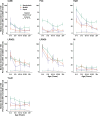Leveraging paired serology to estimate the incidence of typhoidal Salmonella infection in the STRATAA study
- PMID: 41066482
- PMCID: PMC12527133
- DOI: 10.1371/journal.pntd.0013612
Leveraging paired serology to estimate the incidence of typhoidal Salmonella infection in the STRATAA study
Abstract
Serologic surveillance of at-risk populations can be used to directly estimate the incidence of typhoidal Salmonella infection across a variety of settings, including those without access to facility-based blood-culture surveillance. We collected paired blood samples approximately three months apart from an age-stratified random sample of healthy children and adults in Bangladesh, Malawi, and Nepal as part of the Strategic Typhoid Alliance Across Asia and Africa (STRATAA) study. We used a multiplex bead assay to measure the concentration of IgG antibodies against seven Salmonella typhi/paratyphi antigens (CdtB, FliC, HlyE, LPSO2, LPSO9, Vi, and YncE) in each sample and identified recently infected participants by fitting a regression mixture model to the change in IgG concentration between participants' samples. We estimated the seroincidence of infection in a Bayesian framework for each study site, age group, and antigen target. Finally, we compared the seroincidence estimates with crude and adjusted estimates of clinical incidence based on blood-culture surveillance. Seroincidence estimates were significantly higher than enteric fever incidence across all study sites, age groups, and antigen targets, even after adjusting for underreporting (median ratio: 24.2, interquartile range: 11.4-58.9). Seroincidence consistently peaked in the 0-4-year age group and declined moderately between children and adults (33% to 58% decline in HlyE seroincidence between the 5-9 and 30 + year old age groups), while enteric fever incidence peaked in older children and fell sharply in adults (71% to 95% decline in adjusted clinical incidence). Seroincidence estimates based on the FliC, YncE, and HlyE antigens individually had the strongest correlation with observed enteric fever incidence across age groups and study sites (r = 0.72, 0.69, and 0.63, respectively). These findings suggest that in endemic settings, both children and adults are frequently infected by typhoidal Salmonella serotypes, although only a fraction of these infections present as clinically identifiable enteric fever cases.
Copyright: © 2025 Walker et al. This is an open access article distributed under the terms of the Creative Commons Attribution License, which permits unrestricted use, distribution, and reproduction in any medium, provided the original author and source are credited.
Conflict of interest statement
I have read the journal’s policy and the authors of this manuscript have the following competing interests: AJP was the chair of the UK Department of Health and Social Care’s Joint Committee on Vaccination until 2025, was a member of the WHO Strategic Advisory Group of Experts (SAGE) until 2022, and is the chair of the WHO Technical Advisory Group on Salmonella vaccines. VEP and FQ are members of the WHO SAGE typhoid working group. JDC and MAG are members of the WHO Technical Advisory Group on Salmonella vaccines. AJP receives grants from the Wellcome Trust, the Coalition for Epidemic Preparedness Innovations, Medical Research Council, National Institute for Health and Care Research, AstraZeneca, European Commission, and Serum Institute of India. VEP receives grants from Gavi, the Vaccine Alliance, US Centers for Disease Control and Prevention, National Institutes of Health/National Institute of Allergy and Infectious Diseases, and National Institute for Health and Care Research. All other authors declare no competing interests.
Figures




References
MeSH terms
Substances
Grants and funding
LinkOut - more resources
Full Text Sources

